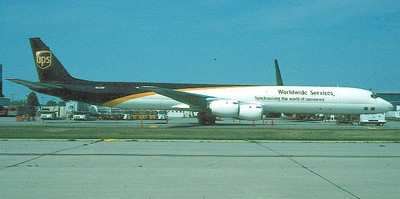Says System Could Have Prevented UPS DC-8 Blaze
 On Tuesday, the National
Transportation Safety Board called upon the Federal Aviation
Administration (FAA) to require all cargo airplanes operating under
Part 121 Code of Federal Regulations install fire suppression
systems. The recommendation came as a result of the Board's
investigation of a UPS DC-8 cargo fire in Philadelphia last
year.
On Tuesday, the National
Transportation Safety Board called upon the Federal Aviation
Administration (FAA) to require all cargo airplanes operating under
Part 121 Code of Federal Regulations install fire suppression
systems. The recommendation came as a result of the Board's
investigation of a UPS DC-8 cargo fire in Philadelphia last
year.
Also this week, the Board released its probable cause report on
that incident -- ruling an in-flight fire initiated from an unknown
source within one of the containers in the main cargo
compartment.
As ANN reported, overheating
lithium battery cells were believed to be the culprit throughout
the investigation into the February 7, 2006 incident. The NTSB
couldn't confirm those beliefs with the evidence at hand, though it
did note several devices onboard did contain such batteries.
Regardless of what caused the fire, the report concluded the
threat from cargo fires could be mitigated by the installation of
fire suppression systems.
"While we may not know the source of the fire which caused this
accident, our investigators have done an excellent job of
highlighting possible solutions that will address hazards
associated with in-flight fires," said NTSB Chairman Mark V.
Rosenker.
In its report, the NTSB states examinations of the recovered
components revealed no evidence of any preexisting powerplant,
structural, or system failures. Also noted was that given the
length of time that the fire burned and the resulting destruction
of potentially helpful evidence, the post-fire condition of the
cargo containers and contents and the surrounding airplane
structure provided no evidence that indicated what initiated the
fire.
Investigators also reviewed the fire and smoke detection system
certification requirements. In the Board's determination, the
examination revealed the current certification test standards and
guidance for smoke or fire detection systems onboard many aircraft
are not adequate -- as they do not account for the effects of cargo
containers on airflow around the detection sensors and on the
containment of smoke from a fire inside a container.
The report states evidence indicates that the fire initially did
not generate a significant amount of smoke, and most likely
initiated as a smoldering fire inside a cargo container. The
construction of the cargo containers, which results in restricted
airflow in or out of the container, likely inhibited the growth and
detection of the fire in its initial stages.
"We have identified several safety issues where improvements in
the aviation cargo industry could make transporting of goods safer.
Our safety recommendations are essential tools that if implemented
can ensure that this will happen," Rosenker said.

As a result of its investigation, the Safety Board made
recommendations in the following areas including: guidance and
checklists relating to in-flight fire and smoke, certification
requirements for smoke and fire detection system tests, fire
suppression system requirements, aircraft rescue and firefighting
training, cargo airplane emergency exit requirements, hazardous
materials information and dissemination procedures, and transport
of lithium batteries on board aircraft.
These recommendations were addressed to the Federal Aviation
Administration, the Pipeline and Hazardous Materials Safety
Administration, and the Cargo Airline Association.
 ANN's Daily Aero-Term (05.01.24): Say Altitude
ANN's Daily Aero-Term (05.01.24): Say Altitude ANN's Daily Aero-Linx (05.01.24)
ANN's Daily Aero-Linx (05.01.24) Classic Aero-TV: Korean War Hero Twice Reborn
Classic Aero-TV: Korean War Hero Twice Reborn Airborne 04.29.24: EAA B-25 Rides, Textron 2024, G700 Deliveries
Airborne 04.29.24: EAA B-25 Rides, Textron 2024, G700 Deliveries Airborne Affordable Flyers 05.02.24: Bobby Bailey, SPRG Report Cards, Skydive!
Airborne Affordable Flyers 05.02.24: Bobby Bailey, SPRG Report Cards, Skydive!




